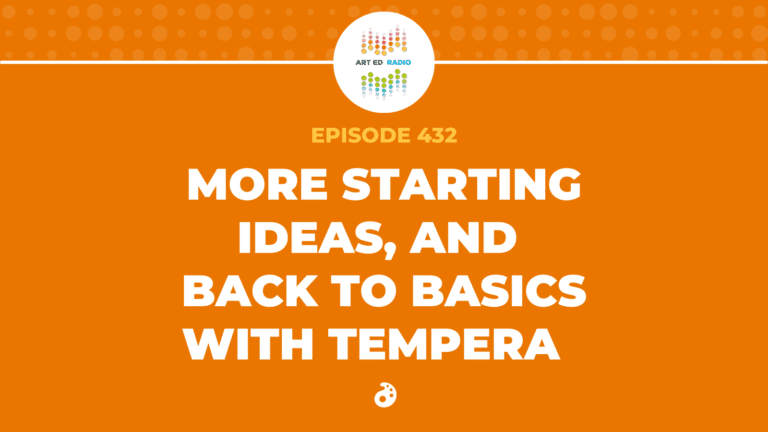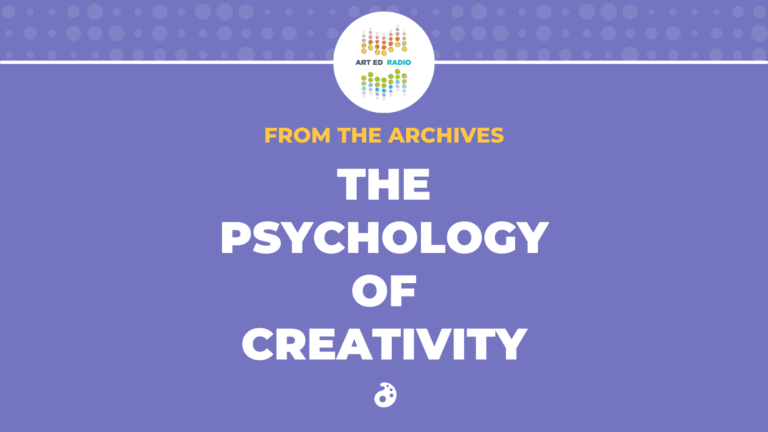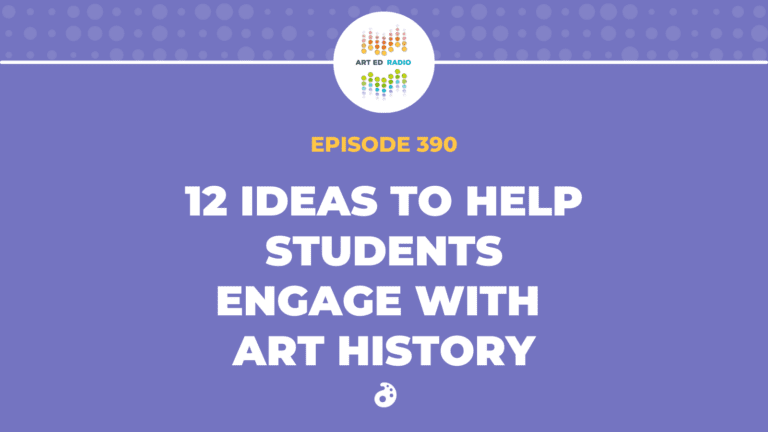Megan Dehner has done videos and PRO packs for AOE, and now she is a part of the writing team. In this episode, Tim brings Megan on to introduce herself, talk about her upcoming writing, and most importantly, her best strategies for teaching English Language Learners. Full episode transcript below.
Resources and Links
- Strategies for English Language Learners (PRO Pack)
- Help Your ELL Students with These Simple Steps
- All of Megan’s Articles

Transcript
Tim: Welcome to Art Ed Radio, the podcast for art teachers. This show is produced by The Art of Education, and I’m your host, Tim Bogatz. Today, I am really excited to welcome Megan Dehner to the show. If you’re not aware, Megan is AOE’s newest writer, and she has already published some incredible articles in the short time that she’s been writing for this site. You may have also seen her if you are an Art Ed PRO member. She has been the facilitator for packs on literacy strategies, teaching kindergarten, budgeting, and teaching English language learners. In fact, that final topic is what she and I are going to talk about today, strategies for teaching your English language learners.
Now, Megan has a great article coming out tomorrow, I believe, that talks about all of the challenges these students face throughout the day. It also talks about why art is the perfect subject to help us reach these students and gives you some strategies on how to make those ideas work in practice, how to make them work in your classroom. Megan can tell you, much better than I can, about all of those things, so I will let her do that in just a second here.
Before we bring her on, though, I want to talk about Art Ed PrRO. I just told you about all of the learning packs from Megan, but there are another 85 or 90 packs available now, as well. That library has on-demand professional development with video tutorials, downloadable handouts, and all kinds of other resources to help take your teaching to the next level. There are three new learning packs released on the first of each month and the library continues to grow. Make sure you check it out at theartofed.com/pro. Once you’re done listening, go see what’s there. But, in the meantime, let’s bring on Megan so everyone can get to know her just a little bit better.
All right, Megan Dehner is joining me now. Megan, how are you?
Megan: Oh, I can’t complain. I can’t complain. How are you?
Tim: I’m doing really well. I’m excited to chat with you. I’m excited to kind of introduce you to our audience. You’ve been writing for us for a little bit and I know people have checked out a lot of your articles, but can you just kind of tell everybody who is listening just a little bit about yourself, about who you are as a teacher, what you enjoy teaching, and what you do, and maybe a little bit outside the classroom, too, just kind of who you are as a person outside of teaching?
Megan: I am an elementary art teacher in West Liberty, Iowa, at the elementary school. I teach kindergarten through fifth grade. I have about 625 kiddos, and I see them throughout the week every week, and I live in Iowa City, Iowa, and went to school there, as well, so I’m a Hawkeye. I originally got my BSA in printmaking and then decided that I really wanted to share my love of creativity, so that’s why I became a teacher. I have been teaching … This is my seventh year? Yes, seventh year of teaching. I taught middle school before elementary. This is my fourth year at my elementary school. I’m always busy in the classroom, but outside of the classroom, I have two small children and my husband, who is actually a teacher, too, and we’re just trying to live the dream. So, things are good.
Tim: I want to ask you, though, just a little bit more about your teaching and I guess what people can expect from you as a writer here. As a teacher, what are you specifically passionate about? What are you gonna be writing about on the AOE website in the coming months? What should we be looking out for from you?
Megan: Sure. Well, first of all, I’m really excited to be a part of the AOE team. It’s really cool, and it feels so awesome to be a part of it, but as a teacher, I am just really passionate about my students practicing their creativity and setting up opportunities for them to do that, whether that be a formal lesson or in several other modalities, but the idea of practicing creativity. There are so many times I hear … I don’t say, “Well, I’m not good at art,” or, “I can’t draw.” It’s getting rid of that mentality that that’s what art is, and yeah, so it’s a part of being in art class, but it’s not the art class, and so giving my students the opportunity to practice what they can’t in other areas of the school or outside of school. Through my articles that I’ve kind of been drafting, I’m diving into a few things that are really specific and super art-related, but then also more large scope. In December, I think there’s when I’m writing about … Not I think, I know, about reclaiming clay and what to do with that solid block of dried out clay that you, as an art teacher, would find tucked in a corner somewhere.
Tim: Yep.
Megan: Talking about some literacy strategies to use within the classroom to connect the creativity that you do visually to the creativity you could do with literacy, and then finally, being the only art teacher at the elementary level at my school and I have a … There’s a large staff I work with. You’re gonna encounter, what I call, scrooges or negativity. As an art teacher when you’re kind of a solo person, an island, it can be really … Or maybe you’re in a time of negativity for yourself, realizing that it’s time to turn to the positive or look for the positive people that are around you. You have to be intentional about the community that you seek out when you’re the only one in the building. We’ll see where it leads. I’m excited.
Tim: I’m excited to read those, too. I think that’s a lot of really good stuff to look forward to. I think that idea of seeking out who you’re spending time with, who you have around you, and making sure that those are the right types of people, I feel like that could be a whole nother podcast, but …
Megan: Totally.
Tim: I think that it is an important point, but I know another thing that you’re passionate about is teaching English language learners, and that’s what I really-
Megan: Yes.
Tim: Want to kind of dive into here. Your article, which comes out tomorrow, I love the opening of that. I love how you kind of explain things. Can you kind of share with our readers and kind of take us through maybe the day from the perspective of an English language learner and talk about all the challenges that they’re gonna face throughout the day?
Megan: Totally. Well, here at my elementary school or in my district, it sounds like, oh, a little town rural Iowa. Well, actually, in West Liberty, Iowa, it’s almost 50% Hispanic population, and with that, our school has developed a dual language program. Half of my students are learning a second language, whether it be English as their second language or Spanish as their second language. It’s a really interesting environment, and so with about a third of my students being true ELL learners, I have discovered that they’re an awesome population to teach and work with. I know that it’s a growing population everywhere. Students who are ELL learners, they face more challenges throughout the day in terms of the transactions that they have throughout the day, how I talk about it in my article, often times, the menu says salisbury steak or chicken pita pockets.
Like, what are those? They look at that and they don’t know what they’re even having for lunch, and so that kind of thing can really be a stressor for an ELL student, and so they have a couple more … Like, how do I ask to go to the bathroom? Where do I stand up in line? What are the expectations when I get out of the car? Do I go straight to my classroom? And so, those types of things are always going to be something for them to figure out, along with the academic rigors that they’re learning, and so outside of academics, they’re worried about all of these little interactions, and having to navigate those, and being just really conscious of them. They have a lot more to worry about.
Tim: Are we able, in our class, to kind of eliminate some of those stressors? ‘Cause you talk in your article a little bit about art class being kind of a relief for students …
Megan: Totally.
Tim: Who struggle with those language barriers. So, why do you think that is? Why can it be such a relief or such a break for them?
Megan: We work in a visual language, not a verbal language, in the art room. Everything that is done is supported by something that you can see. We, luckily, can use words to help understand it, but our main way of understanding it is through visual, and so they can watch, and see, and then do, and then whatever they do isn’t wrong. That’s the awesome thing about the art room, is that there’s no wrong or right, and so it’s a place for them to not ever feel that they’re outside of the norm.
Tim: I think we can be conscious of …
Megan: Totally.
Tim: But I also want to talk about, as we’re working with those English language learners, I want to talk about some strategies that can help them, that can put them more at ease and things that can benefit them. Do you have any suggestions for maybe just some small things that you can do to help your language learners or just a couple things that people who are listening to this can just do easily today that would be beneficial for those kids?
Megan: I like to say, and my other fancy ELL teachers would agree with me, that what’s good for an ELL learner is good for everyone, including you as the art teacher. If a routine isn’t working or if students are confused and there is something that you can do to streamline or help understanding, it’s not just gonna help the ELL student. It’s going to help the student that’s perfect in their native language. It’s going to help you keep organized as the teacher. Anything that you do intentionally targeting your ELLs is going to be awesome for everyone. With that, things like consistent routines and making sure that things are streamlined, but in terms of things that you could do today, one thing that I think that people don’t think about is, there are, more than likely, at least one or two, depending on your district needs, ELL instructors within your building or district. Ask them what populations or what students that they are worried about or working with, who just came to the district, where are the needs?
And so if you’re noticing that someone consistently is not following routines, but you think that they understand you, they might be an ELL student and you don’t know it. Asking an ELL instructor for their input or their opinion about a student or a group of students is something you could do today. Also, thinking about labeling things really simply, but not overboard. If you’re noticing that, for example, your supply table always ends up being a crazy mess, label that. You don’t have to label everything in the room. You don’t have to say door. You don’t have to say chair, but just one … Notice a problem area and maybe try to change that area.
Tim: And just that idea of labels kind of gets me thinking a little bit more of long-term, too.
Megan: Totally.
Tim: I’m huge into organization and labels, ’cause like you said, those are things that are good for every kid. I think those are worthwhile goals no matter how much English language learners you have, but just kind of looking at that long-term perspective, what other types of things should you be trying to do? What could be long-term goals or strategies that you can use or ways to organize your room that are really gonna help students be more successful?
Megan: Totally. Well, labels, I do say that you could do a quick label, but having consistent labels that … Something long-term. Don’t go crazy with it today, but thinking about using the same label for the actual item and maybe the container it goes into, also showing that on the screen as part of a required material for a certain project. So, if a certain project is going to require collage materials, glue, scissors, scraps, whatever, have that same icon, font, and lettering to match the containers that those things will be in that the students can access.
So, they’re seeing it twice, both, when you present the lesson or the project and then they see it again actually with the item, so consistency with that, making videos of routines or simple things like an electronic pencil sharpener. I had to make a short video of how to do that properly because my pencil sharpener is apparently very finicky and temperamental. I had to do a quick video to show my students, this is how you do it, and it was up close, and personal, and blown up so that they could all see it, and then that way they know every time, that that’s how long it takes to get a good, sharpened pencil. I mean, these are the things that art teachers deal with and can literally make or break a class if they’re constantly having to show the pencil sharpener routine.
Think about those routines that you can show in a video, and it doesn’t have to be fancy, just a quick cell phone one that you then have at your disposal to show again and again as students may need reminders, or like the routine to wash hands, or how to clean a … I almost said toothbrush … A paintbrush. Those types of things are things that not only will help your ELL student know, oh, but these are also the expectations. When I need my pencil sharpened, I know what to do. I don’t have to ask somebody. I don’t have to … I can just do it. Those will help to remind not only your ELLs in there learning but the whole classroom.
That’s another thing, is think about videos that you can make that you could use over and over again, and then also think about building a library of books and visual resources that can supplement and encourage the creativity. For example, the Mix It Up or Press Here books by … I’m saying his name wrong, but Hervé Tullet. He did a really nice job just using the visual language of dots and colors to then explain color, so using those as part of your teaching and think about building your library for your art room. There is so much you can do, not to do it all at once, and know that anything that you decide to do will benefit everyone.
Tim: Yeah. That is a lot of really great advice and I think a good closing message there.
Megan: I know. It’s a lot. I want to say that I have a hard time doing it all. I constantly am thinking, oh, I should really make a video for that, and it takes a while to do it, or, oh, gosh, we’re really having a hard time with cleaning the rollers. I should make a video of that. There are all of these things that we know that happens in our head that we want to do, but when you eventually do them, it’s beneficial, but it’s overwhelming to think of it all the time.
Tim: Yeah, absolutely. I think it’s important that we don’t try and do it all at once, and we talk about that a lot on the podcast here where if you’re implementing new ideas, you don’t have to do them all right now. It can be a progression.
Megan: No.
Tim: I think that fits in perfectly with what you’re saying here, just a little bit at a time, it’s gonna help you. It’s gonna help all of your students, as well, and so that’s kind of where our focus needs to be. All right, well, thank you, Megan. We’ll go ahead and wrap it up there. It’s been awesome talking to you. I appreciate you sharing all of those strategies. Hopefully, we can have you back on the podcast again soon.
Megan: Sounds good. Thank you.
Tim: Thank you to Megan for taking some time out to talk to me today. Just kind of thinking about what she had to say in the conversation and all of those things she talked about, there are some great strategies in there, but I think the most important thing she said, and probably the takeaway that everyone should have from today’s conversation, is that what’s good for your English language learners is good for all of your students. It’s honestly just a matter of best practices. When you’re thinking about your teaching strategies and what you can do to help your English language learners realize that what you’re doing goes far beyond those specific students. Those improvements that you make and what you are doing is going to help everyone.
Art Ed Radio is produced by The Art of Education with audio engineering from Michael Crocker. For those of you that were curious, I did make it through the marathon a couple days ago. Quick thanks to everyone that sent me some notes of encouragement on social media and through email, and a special thanks to those of you who came out to cheer me on. That was pretty spectacular. I finished. I mean, I did it slowly, but I did finish the marathon, so number two is in the books and I’m feeling pretty proud of that accomplishment.
We’ll go ahead and leave it there, and we will talk to you next week. Thank you, as always, for listening.
Magazine articles and podcasts are opinions of professional education contributors and do not necessarily represent the position of the Art of Education University (AOEU) or its academic offerings. Contributors use terms in the way they are most often talked about in the scope of their educational experiences.



